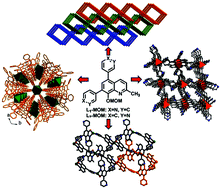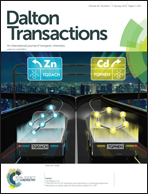Five 8-hydroxyquinolinate-based coordination polymers with tunable structures and photoluminescent properties for sensing nitroaromatics†
Abstract
Using two 8-hydroxyquinolinate ligands (L1-MOM and L2-MOM) containing 3-pyridyl or 4-pyridyl groups, five novel coordination polymers, namely, [Zn3(L1)6] (1), [Zn(L1)2]·2MeOH (2), [Zn(L2)2] (3), [Cd(L2)2] (4), and [Cd4(L1)6]·13H2O (5), were synthesized and characterized by a variety of techniques. Single-crystal X-ray structures have revealed that these coordination polymers exhibit a structural diversification due to the different choices of metal salts and the effect of pyridyl nitrogen position. Compounds 1–5 exhibited different fluorescence emissions and lifetimes upon excitation in the solid state. The sensing behavior of these polymers was also investigated upon exposure to vapors of various nitroaromatic molecules (analytes). The results show that all five polymers are capable of sensing these nitroaromatic molecules in the vapor phase through fluorescence quenching. Interestingly, 3 exhibits superior sensitivity to the analytes in comparison with other polymers. 2-Nitrotoluene quenches the emission of 3 by as much as 96%.


 Please wait while we load your content...
Please wait while we load your content...